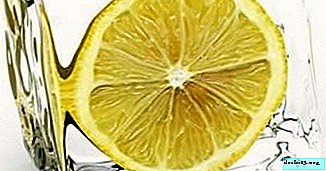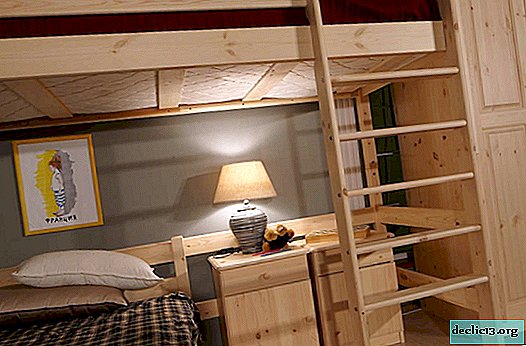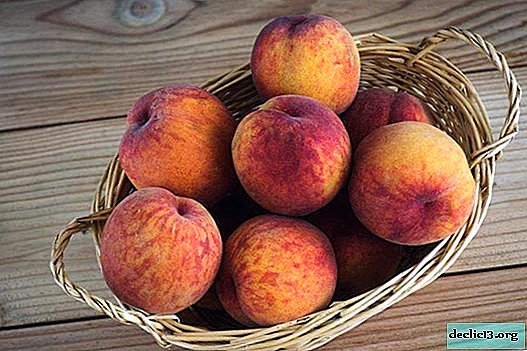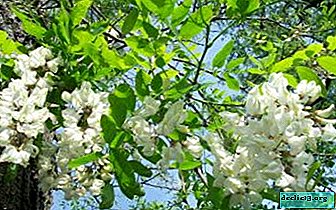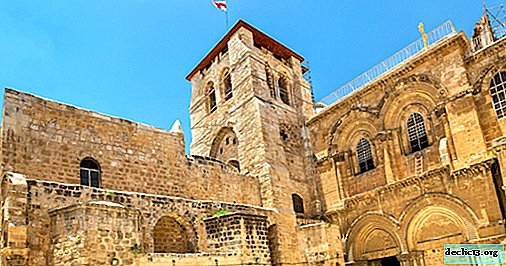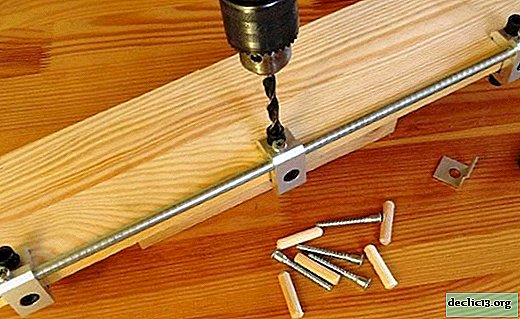The pride of the succulents collection is the leaf cactus of Peresius Godseff: photo, description, growing a house

Many cactus lovers do not pass by this wonderful flower. Peresia Godseff - the oldest species of cacti, different from other succulents and peres with fleshy leaves, which attracts the attention of cacti growers, long tired of more prickly "friends". In care, this plant is unpretentious and will decorate any collection of cactus growers. This article will tell you what Godseff Peresia is, what it looks like, how to care for this cactus, how to propagate Peresia by cuttings and seeds, how it blooms and what pests it can be threatened with.
Botanical Description
Pereskia Godseffa (Pereskia godseffiana) has thin stems with black spines, growing bunches. Despite the fact that this plant belongs to the cactus family, the leaves are not represented by thorns, but by whole leaf blades up to 6 cm long. The lower leaves have a pinkish or purple hue.
During flowering, forms medium-sized flowers of white or cream color. It can grow up to 10 meters tall. Basically, this plant does not use other trees as a support and is not a vine, however, sometimes it uses supports for its further growth in height. For use in vertical gardens, this view is not suitable.
The homeland of this plant is considered Central and South America, steppe or transitional to steppe climatic zones. The first mention of this cactus was recorded in 1703. Only in 1754 this plant was added to the Cactus family.
Plant photo
Here you can see what a cactus looks like:





Home Care
- Temperature. During the rest period, the temperature optimum for this cactus will be a value in the range of 12-16 degrees. In the summer, a favorable temperature for this plant will be 22-25 degrees.
Important! In winter, the air temperature should not fall below 10 degrees.
- Watering. In winter, the plant is watered very rarely (1 time per month in small quantities). With the release of the cactus from the dormant period, watering is carried out as the top soil layer dries.
- Shine. The best location for this cactus would be a south balcony or window sill. To avoid burns, the plant is shaded. During dormancy, it is best to keep the cactus in a lighted room with adequate ventilation.
- Priming. Most often, a mixture of different types of soil is used.
Typically, a mixture of:
- sheet land (one part);
- clay-sod land (two parts);
- leaf humus (two parts);
- sand (three parts).
In addition, a sufficient drainage layer is needed at the bottom of the pot. Small stones, broken into small pieces of ceramic products, are suitable as drainage. First, a drainage layer is laid out in the pot, then a mixture of soil is poured and a small layer of sand is sprinkled on top. soil acidity is optimal in values from 5.0 to 6.0.
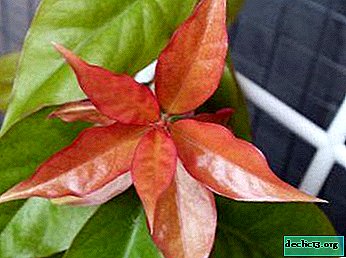 Pruning. The sample occurs before the start of active growth. The main purpose of trimming is to shape the outline of the crown.
Pruning. The sample occurs before the start of active growth. The main purpose of trimming is to shape the outline of the crown.- The desired shape of the crown is approximately pretended.
- Sterile cutting tools trim.
- Cropped cuttings can be placed in a container of water to get the roots.
- Top dressing. Fertilizer is introduced during the period of active growth and flowering. The optimal frequency of feeding 1-2 times a month. Use classic fertilizers for cacti. The predominance of potassium and phosphorus over nitrogen in the composition should be two or three times.
Reference! Excess nitrogen can cause root rot.
- Pot. Ceramic deep and wide pots should be chosen because the root system of these cacti is very powerful. For beginner gardeners, it is better to purchase pots with a drainage system so that excess moisture does not stagnate in the pan. Stagnant water in the pan promotes the growth of fungi and mold.
- Transfer. Plant transplants are performed quite often, up to two times per season. Due to the rapidly developing roots, this cactus grows rapidly and occupies almost the entire area of the pot. After the transplant, the plant should be placed in a cool, shaded area.
- Wintering. At rest, the plant must be placed in a cool place, to minimize watering. However, the humidity should be sufficient, for this you can spray the plant once a week.
Propagation by cuttings and seeds
Reproduction of this cactus is produced by seeds and cuttings. Both methods are quite effective.
Seed propagation:
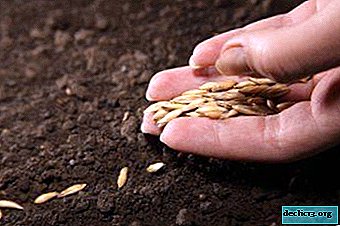 Seed is soaked with a little water for one day.
Seed is soaked with a little water for one day.- Soaked seeds are placed in containers with loose soil.
- Germinate in ambient light.
- After seed germination in seedlings, they are transplanted into separate independent pots.
Propagation by cuttings:
- The cuttings are cut in the summer with a sharp sterile secateurs.
- Cuttings without wood, but already strong, are chosen.
- Place the handle in a container of water, treating the cut with growth hormones.
- After the appearance of the first roots, rooting is carried out in a pot with loose soil.
- The pot is covered with a perforated film and placed in a warm, bright place.
- After growth in a young plant, pinch the top.
We offer you to watch a video about the cuttings of Godseff Peresia:
Bloom
It blooms in the summer, affecting the beginning of autumn. The main distinguishing feature is that the flowers of this genus of plants lack the typical, for cactus, flower tube. Cream-colored flowers, almost always collected in inflorescences. The aroma of flowers resembles citrus. For flowering of Peresius Godseff, a large vegetative mass is necessary, which is difficult at room due to limited growth.
Reference! If the peresia does not bloom, then it should be transplanted into a more voluminous pot. To feed the plant, to accelerate the growth of the vegetative mass, hormonal growth preparations (heteroauxin) can be added.Diseases and Pests
This cactus has a fairly strong immunity. The main bacterial disease is gray rot, which appears with excessive watering. In this case, you should transplant the cactus into a new pot and reduce watering.
Pests - spider mite and mealybug. These pests cause severe damage to the plant, as soon as the first signs of pest habitat appear, it is urgent to rinse the cactus with a warm shower, protecting the soil from water.
A cotton swab moistened in an alcohol-containing solution will help remove the shield from the plant. Running cases of plant disease require treatment with special chemicals.
Similar flowers
 Pereskia orange (lat. Pereskia bleo) is stretched from 2 to 8 m high. Her bush is weakly branched. Bark of young stalks of olive color. Diameter reaches 15 cm.
Pereskia orange (lat. Pereskia bleo) is stretched from 2 to 8 m high. Her bush is weakly branched. Bark of young stalks of olive color. Diameter reaches 15 cm.- Pereskia Grandiflora, or more flowered (lat. Pereskia grandiflora) in the wild grows up to 5 m in height and up to 20 cm in diameter. The stem is covered with spikes 2-3 cm long. It is rough, chestnut-colored. The leaves are elongated, up to 23 cm in length.
- Pereskia prickly (Pereskia aculeata) differs from Pereskia Godseff in green leaves and in that it is a more pronounced vine. Spines on young shoots are curved, brownish-green, on old shoots - straight, stiff and darker. The flowers in this plant are yellow or pinkish-yellow.
- Pereskia Weber (Pereskia webehana) This species, forming bushes 1-3 m in height and having a thickened rhizome, is cultivated as a succulent plant of the bonsai type. White flowers 1 cm in diameter appear from spring to late summer.
This cactus is perfect for a cottage or apartments with large balconies, windows to the south. Pereskia Godseffa loves fresh air and a long sunny day. A beautiful shrub with fleshy leaves, unpretentious to care, pleases gardeners for many years.

 Pruning. The sample occurs before the start of active growth. The main purpose of trimming is to shape the outline of the crown.
Pruning. The sample occurs before the start of active growth. The main purpose of trimming is to shape the outline of the crown. Seed is soaked with a little water for one day.
Seed is soaked with a little water for one day. Pereskia orange (lat. Pereskia bleo) is stretched from 2 to 8 m high. Her bush is weakly branched. Bark of young stalks of olive color. Diameter reaches 15 cm.
Pereskia orange (lat. Pereskia bleo) is stretched from 2 to 8 m high. Her bush is weakly branched. Bark of young stalks of olive color. Diameter reaches 15 cm.